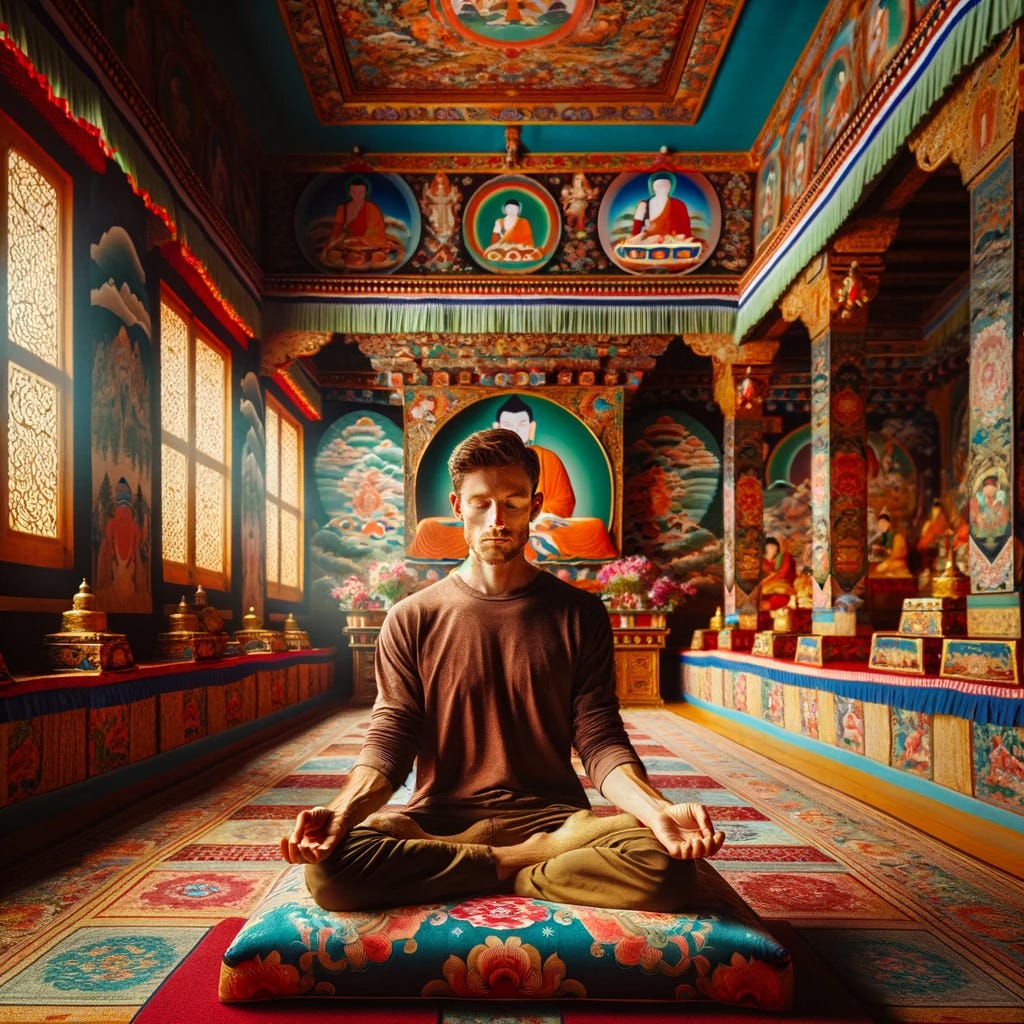Tibetan Buddhist Lamrim: Refuge Practice
Finding support in religious figures, religious teachings, and the community of believers.
Where do people look for guidance and support when circumstances are challenging? For much of the last 2,500 years, many have turned to organized religion.
Jews have God, the Bible’s Old Testament, and synagogues.
Christians have Jesus, the Bible’s New Testament, and Christian churches.
Muslims have Muhammad, the Quran, and mosques.
Hindus have the deities Brahma, Vishnu, and Shiva; holy books, including the Vedas, Upanishads, and Bhagavad Gita; and temples for worship.
And Buddhists have the Three Jewels: the Buddha, the Dharma (teachings), and the Sangha (spiritual community).
Generally, major religions instruct their followers to seek inspiration, guidance, and support from their Gods, holy books, and community of believers. In Buddhism, this is called Refuge Practice.
Here is a summary of the Lamrim teachings on refuge practice:
Understanding the Three Jewels: Lamrim's teachings emphasize the importance of understanding the qualities and significance of each of the Three Jewels:
Buddha: Refuge in the Buddha represents taking inspiration from the historical Buddha, Siddhartha Gautama, and recognizing his enlightenment as a model for one's own spiritual journey.
Dharma: Refuge in the Dharma refers to placing trust in the teachings of Buddhism. This involves studying, contemplating, and applying the Dharma to one's life.
Sangha: Refuge in the Sangha involves seeking guidance and support from the spiritual community, which includes both ordained monks and nuns, as well as lay practitioners who are on the path to enlightenment.
Safe Harbor: Refuge practice is likened to taking shelter in a secure harbor during the storms of life. It provides a sense of protection and guidance amidst life's challenges and uncertainties.
Protection from Negative Forces: Taking refuge is believed to provide protection from negative influences and obstacles on the spiritual path.
Preliminary Practice: Refuge practice is often a preliminary step in many other Tibetan Buddhist practices and rituals. It creates a foundation for deeper spiritual growth.
Development of Faith and Trust: Through refuge practice, individuals develop faith and trust in the Three Jewels as reliable sources of guidance and enlightenment.
Integration with Daily Life: Lamrim's teachings stress the importance of integrating refuge practice into daily life. This involves applying the teachings of the Buddha and seeking the support and companionship of the Sangha community.
Progression on the Path: Refuge practice is often seen as the first step on the path to enlightenment. As practitioners deepen their understanding and commitment, they progress through various stages of spiritual development outlined in the Lamrim.
In summary, refuge practice in Tibetan Buddhist Lamrim teachings involves seeking spiritual shelter and guidance in the Three Jewels as a means to navigate the challenges of samsara and progress on the path to enlightenment.
It is both a foundational and ongoing practice that helps individuals develop faith, trust and a deeper connection to the Buddhist tradition.
From my teacher.
A personal note on Buddhist Faith
As a Westerner, I was not born into a Buddhist culture or a Buddhist household. I knew nothing about Buddhism growing up.
Like many other Westerners, I found my religious tradition, Roman Catholicism, lacking in so many ways that it was simply untenable. I rejected everything and considered myself an atheist for many years.
My first meaningful exposure to Buddhist ideas occurred in my early 20s when I began meditating and reading books about mysticism. My budding practice didn’t become more serious until I reached 30.
Buddhism didn’t put me off because it seemed like a Godless religion. The focus was on my experience and relieving my suffering, not blind obedience to an imaginary God and his flawed intermediaries on earth.
My faith in Buddhism grew out of my practice. As I saw more results, I became more motivated to continue. My faith is not blind; it’s rooted in my personal experience.
Many Buddhist practitioners relay the same message. Buddhism doesn’t require faith, at least not like accepting an imaginary God that one is free to believe in or not.
Buddhism asks that you suspend your disbelief and try the practice, observe the results the practice produces in your life, and then decide if you want to go deeper.
I found it was like any other activity. The more I practiced, the better I became at it, and the more I enjoyed both the practice and the activity, and in this case, the activity is living a happy life.
As the Buddha is believed to have stated:
Do not believe in anything simply because you have heard it.
Do not believe in anything simply because it is spoken and rumored by many.
Do not believe in anything simply because it is found written in your religious books.
Do not believe in anything merely on the authority of your teachers and elders.
Do not believe in traditions because they have been handed down for many generations.
But after observation and analysis, when you find that anything agrees with reason and is conducive to the good and benefit of one and all, then accept it and live up to it.
That’s what I did.
You can do the same.
Meditation on Refuge Practice
The essence of refuge practice is making a choice to follow the path.
It’s a particular problem with New Age dabblers and beginning meditators that they don’t know where to turn, so they do one thing for a while, then they change their minds and do something else.
If someone is unwilling to commit to any particular practice, then they rarely make any progress, and they bounce aimlessly from one cool idea to another and fail to accomplish anything.
When people start refuge practice, they begin to look at Buddhist texts, Buddhist stories, and Buddhist teachers for wisdom and guidance.
Then they make progress, see the results, and dive ever deeper into the practice.
Contemplation
Consider what you read in this post and focus on the following first-person narrative:
If I seek guidance from Buddhist teachings, meditate with pure intention, and discuss my experiences with Buddhist practitioners, I will make steady progress, enjoy peace of mind, and achieve final liberation and lifelong happiness.
Meditation
When the feeling of determination arises to rely on Buddha, Dharma, and Sanga as refuge, hold this feeling for as long as possible without forgetting it.
When you are not in meditation, when challenges arise, the motivation to seek answers in the three jewels should also arise. This will accelerate your progress.






